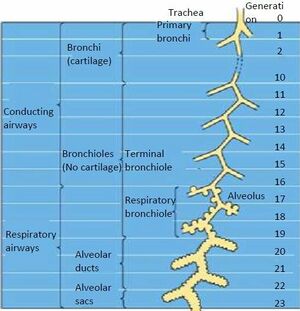Tracheobronchial Tree
Original Editor - User Name
Top Contributors - Stella Constantinides and Kim Jackson
Introduction[edit | edit source]
The tracheobronchial tree is a branching tree of airways composed of:
- the trachea
- the bronchi
- the bronchioles.
Main function of the tracheobronchial tree is to allow the transport of air to from the environment to the lungs for gas exchange.
In all, there are approximately 23 generations (divisions) of airway in the human lung extending from trachea (generation 0) to the last order of terminal bronchioles (generation 23).
Trachea[edit | edit source]
The trachea is a U-shaped structure that is composed of hyaline cartilage on the anterior and lateral walls, with the trachealis smooth muscle forming the posterior border of the trachea .Also the trachea is composed of several primary structural annular ligament.https://www.sciencedirect.com/topics/medicine-and-dentistry/trachealis-muscle , https://www.ncbi.nlm.nih.gov/books/NBK448070/
- The trachea descends from the larynx into the lung
- Is situated anterior to the oesophagus. (biblio)
- .Extends from cricoid cartilage to carina.
- 10-12 cm long /2.0-2.5 cm in diameter.
- The trachea bifurcates into the right and left main bronchi, which then supply their respective lungs. This point of bifurcation is termed the 'carina'. (book)
https://www.ncbi.nlm.nih.gov/books/NBK448070/
Hyaline cartilage = Series of 16 to 20 hyaline cartilage rings each is individually connected by an annular ligament.
Trachealis muscle = This muscle allows the tracheal lumen to decrease during the cough reflex, with the smaller aperture allowing greater velocity to be achieved and the particle to be expelled. http://education.med.nyu.edu/Histology/courseware/modules/respiratory-sy/respiratory.07.html
Bronchi[edit | edit source]
At the level of the fifth thoracic vertebra, the trachea divides into the left and right main bronchi. The right main bronchus has a length of 2.5 cm, and the left main bronchus is 5 cm long
Right main bronchi
- 2.5cm
- Wider
- More vertical.
- Left main bronchi
- 5cm
- Narrower
- More horizontal
Bronchioles[edit | edit source]
The bronchioles are the final air conductors, and by definition, lack cartilage altogether (and are therefore sometimes referred to as membranous) (Fig. 1.11). The bronchioles have no alveoli; alveoli are acquired more distally in the pulmonary acinus. The terminal bronchiole is the smallest conducting airway without alveoli in its walls. There are about 30,000 terminal bronchioles in the lungs, and each of these, in turn, directs air to approximately 10,000 alveoli. The cells that line the airways are columnar in shape and ciliated. Their nuclei are present at multiple levels in each cell—a phenomenon referred to as pseudostratification.
Resources[edit | edit source]
- bulleted list
- x
or
- numbered list
- x







